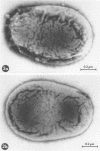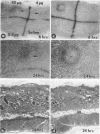Abstract
Two types of toxic fractions, protein-rich and carbohydrate-rich, were isolated from attenuated (strain 19) and virulent (strain 2308) Brucella abortus organisms. Polyacrylamide gel electrophoresis of the protein-rich fraction, in the presence and absence of sodium dodecyl sulfate, revealed qualitative and quantitative differences in the protein bands derived from the attenuated and virulent strains. Sodium dodecyl sulfate-gel electrophoresis indicated that the major differences between these protein fractions were in the molecular weight range from 14,000 to 40,000. Immunoelectrophoresis of these fractions from the attenuated and virulent strains revealed differences in the antigenic spectrum. Polypeptides in the carbohydrate-rich fraction could be visualized on polyacrylamide gels only when reacted with fluorescamine before electrophoresis. Immune sera did not precipitate the components of the carbohydrate-rich fraction. Intradermal injecttion of the protein and carbohydrate-rich fractions resulted in different types of skin lesions in guinea pigs, i.e., edematous/erythematous and necrotic lesions, respectively. Fractions derived from attenuated and virulent strains of B. abortus were equally toxic in the guinea pig skin test. The toxic activity of both types of fractions was susceptible to pronase and heat treatment.
Full text
PDF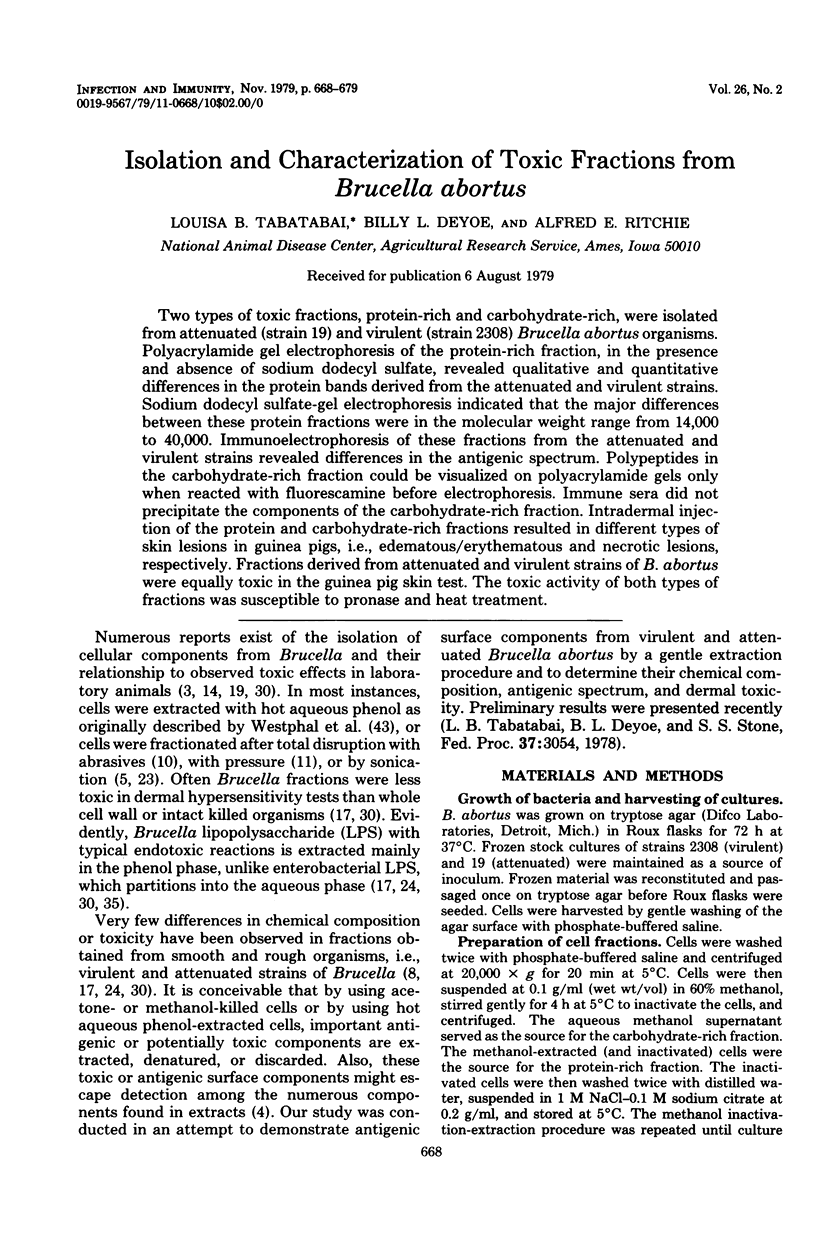
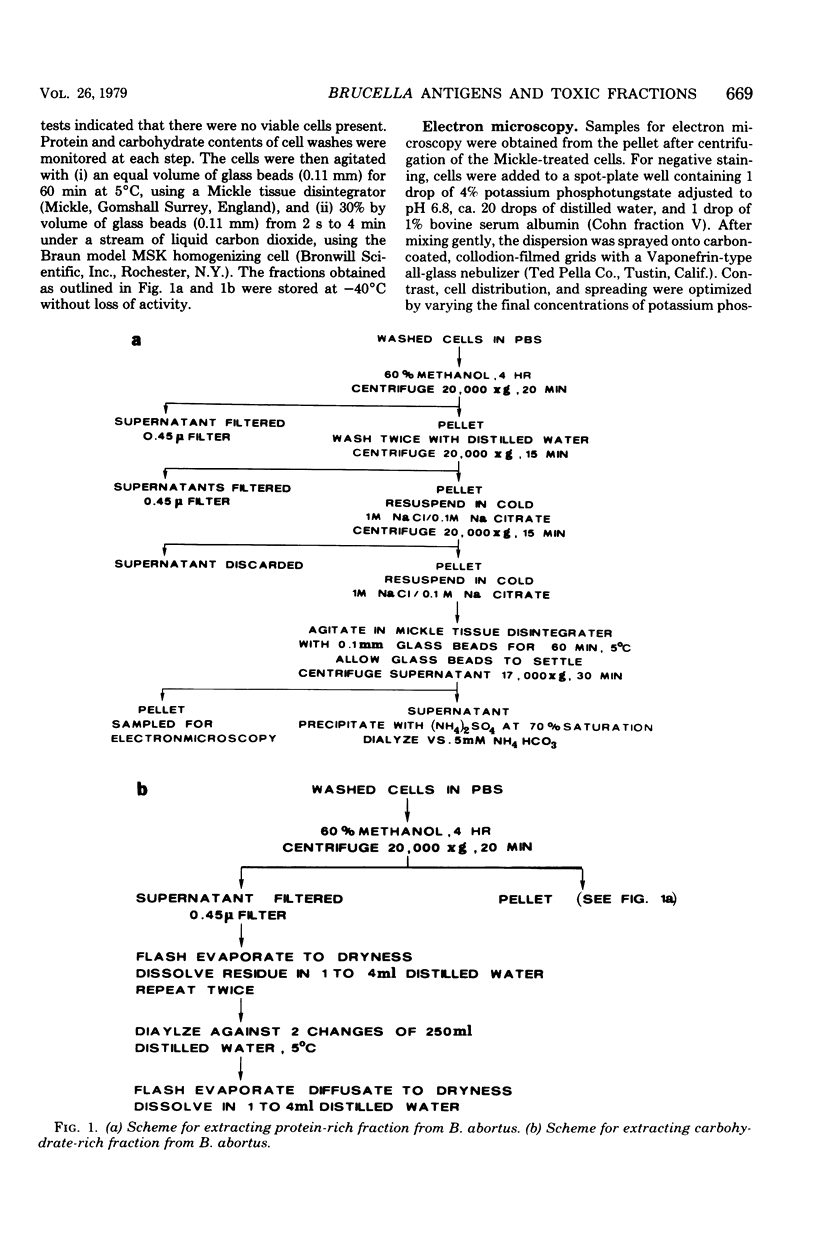
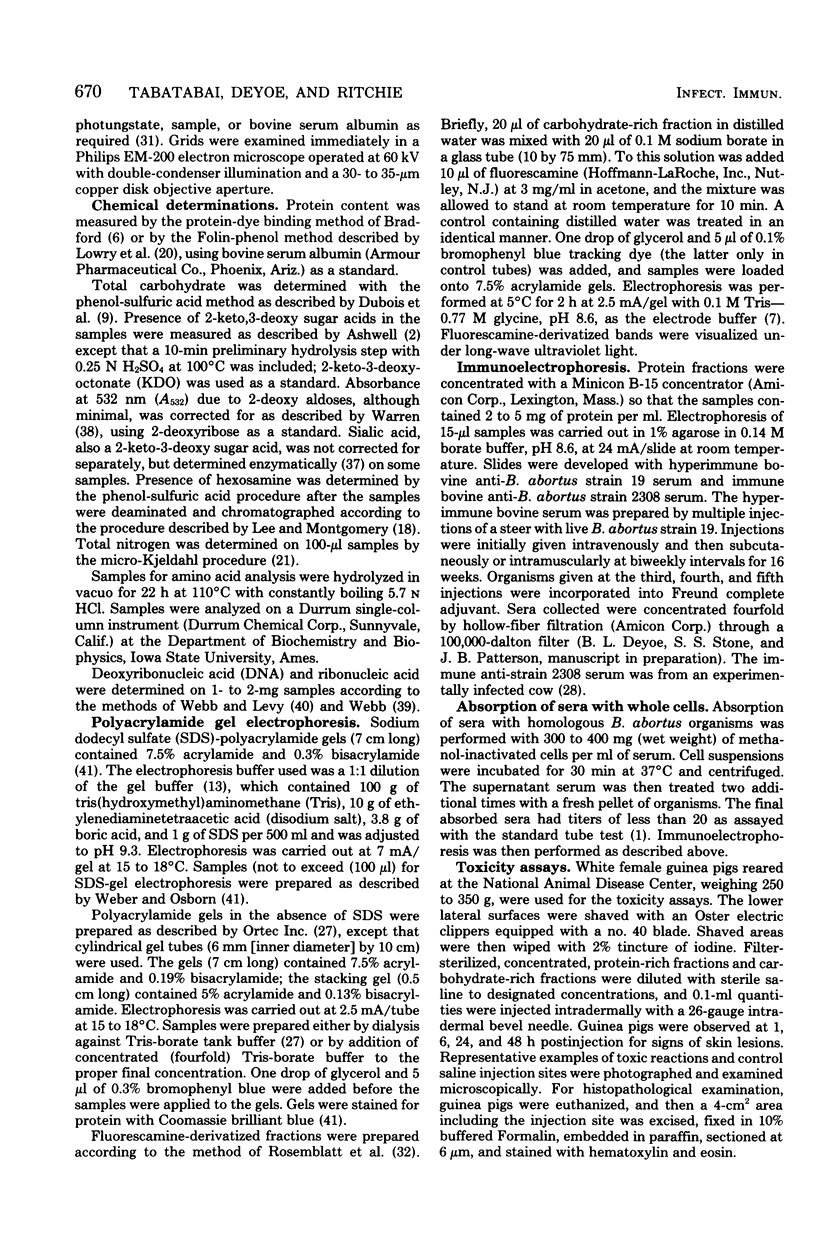

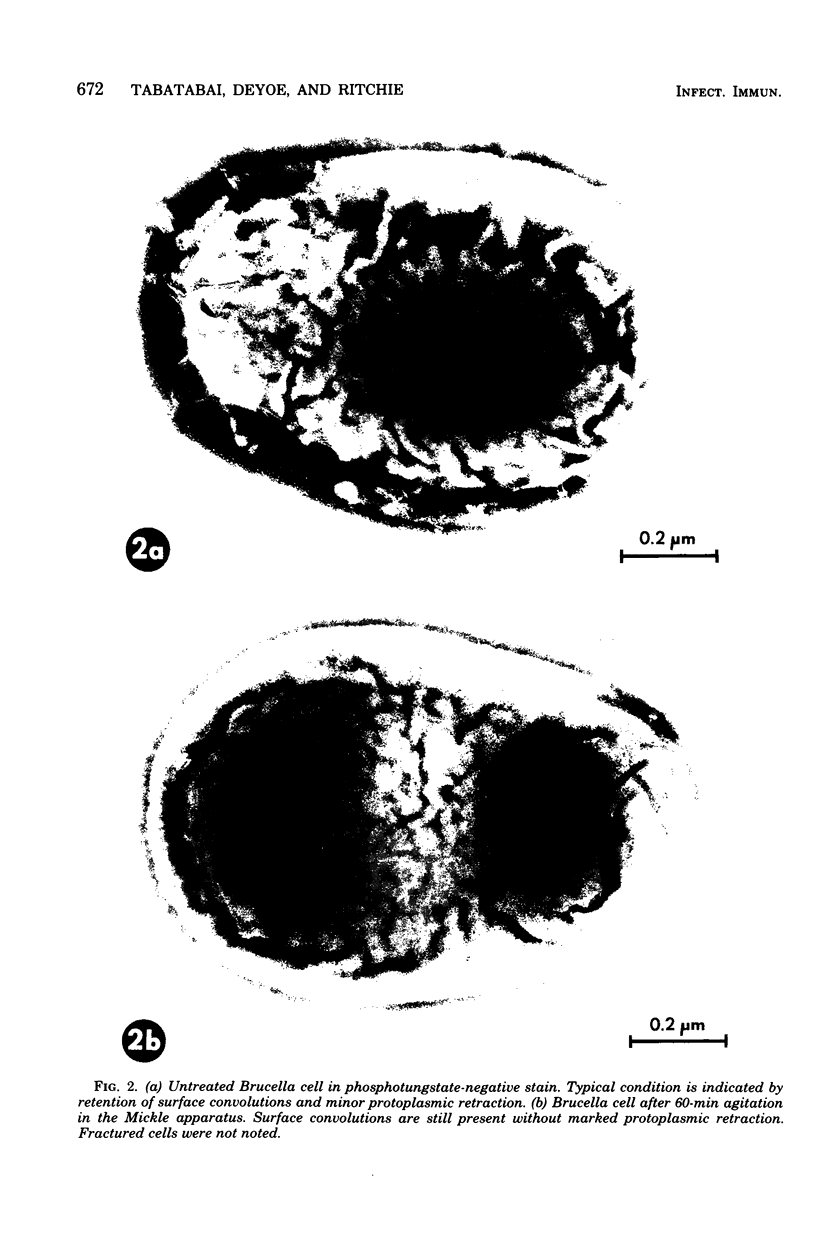
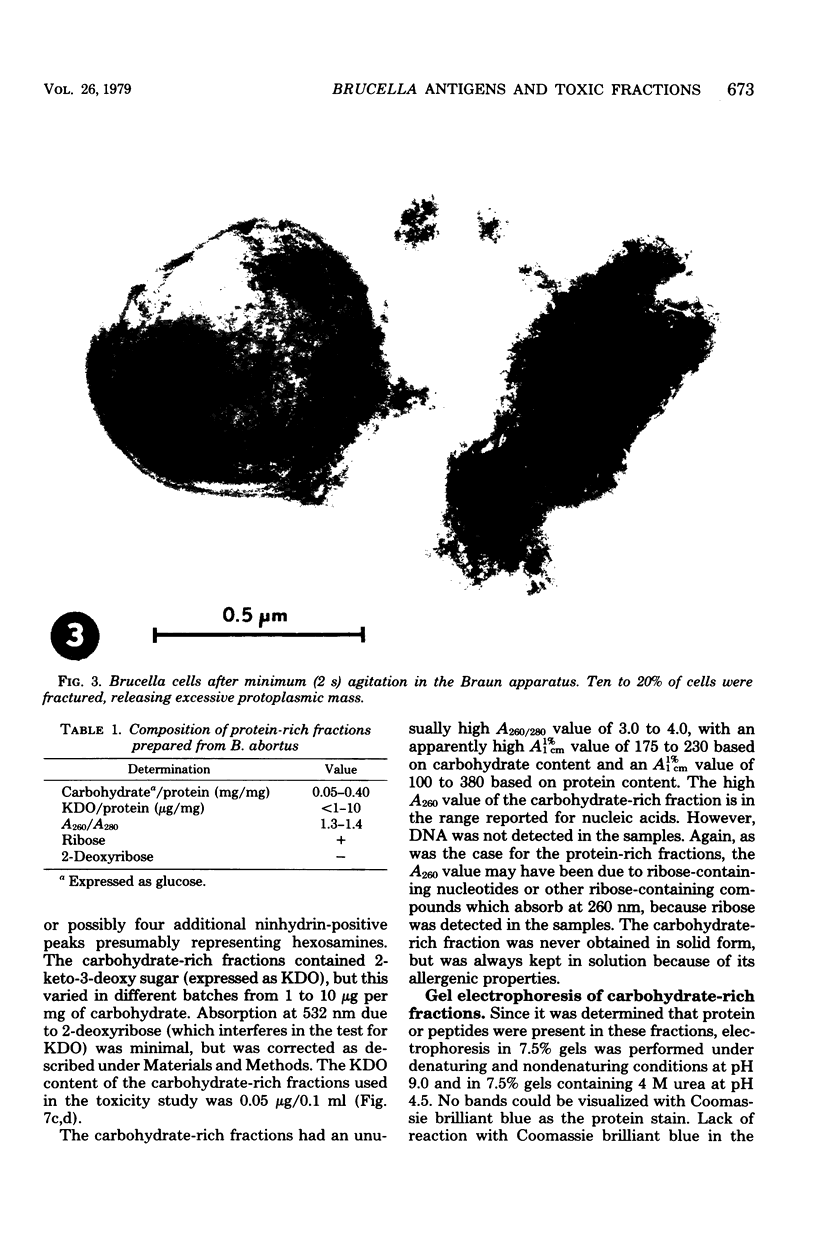


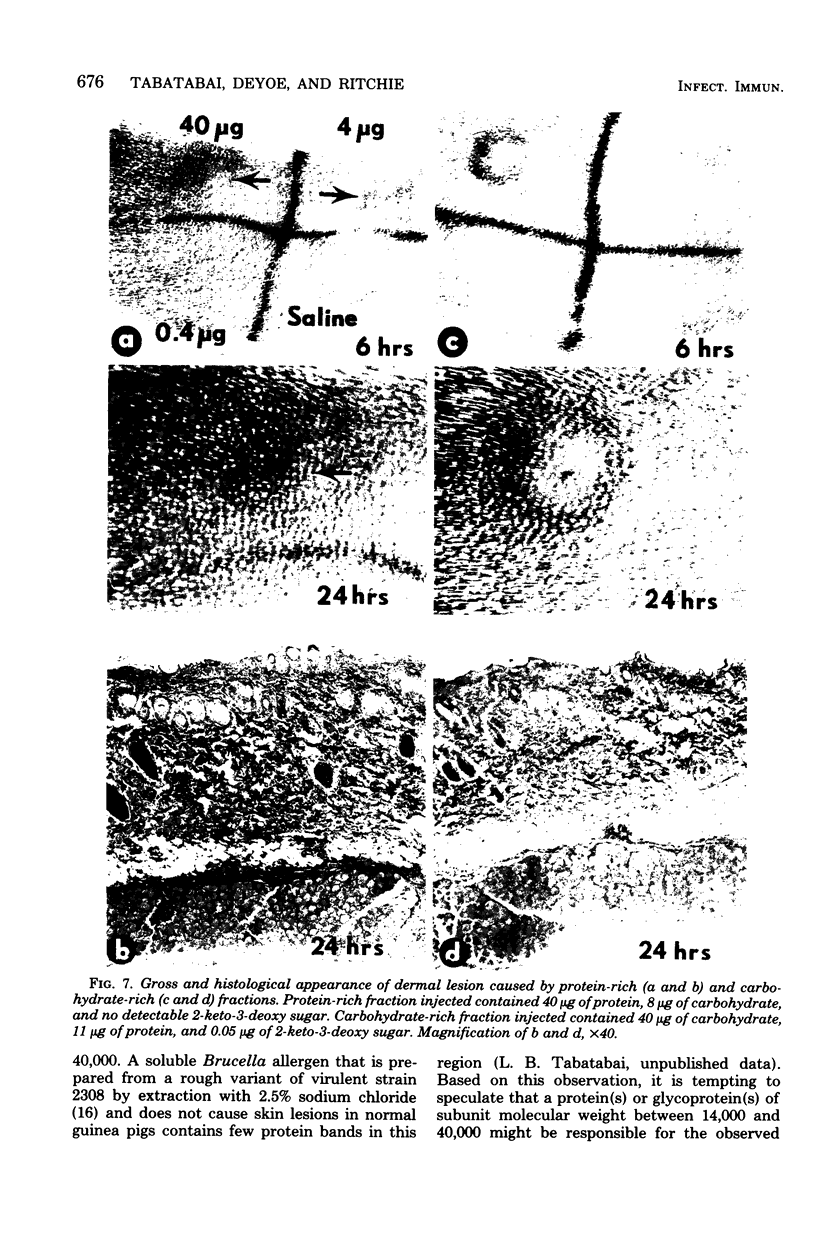
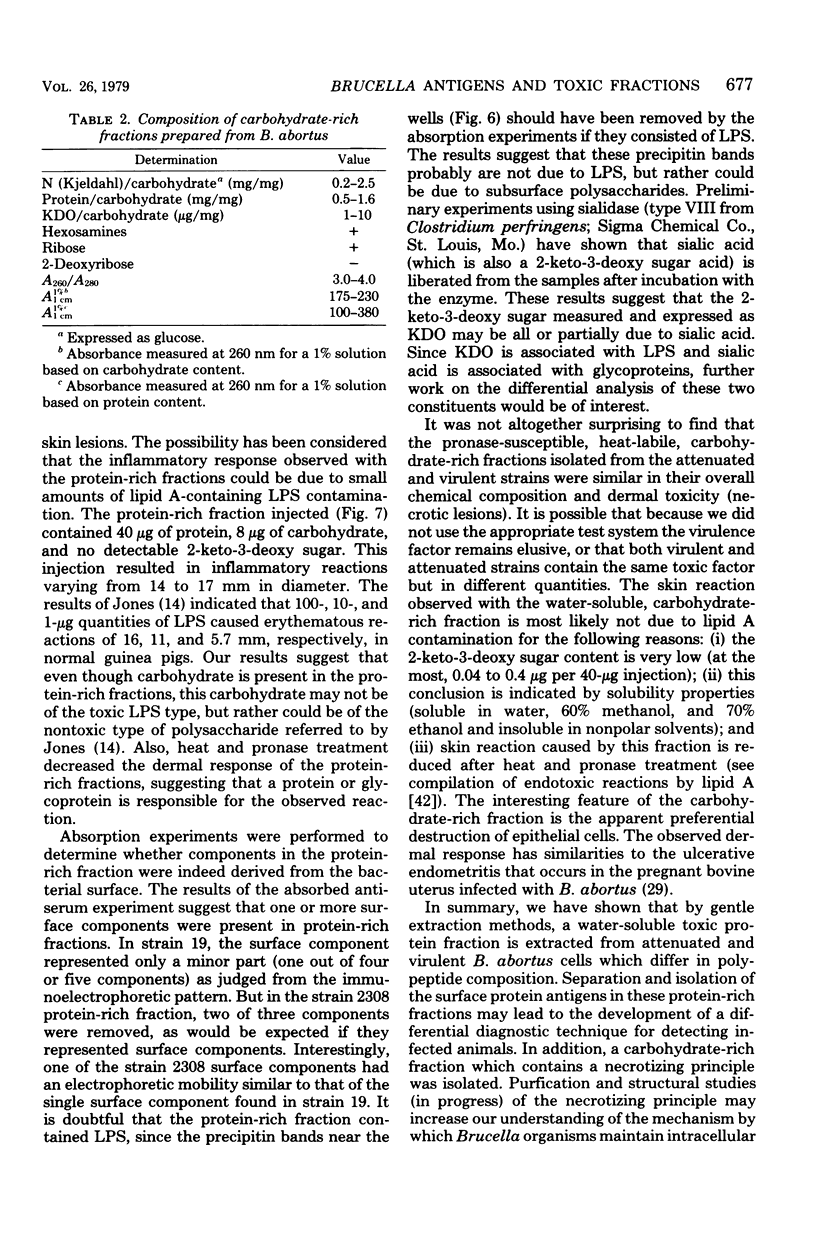
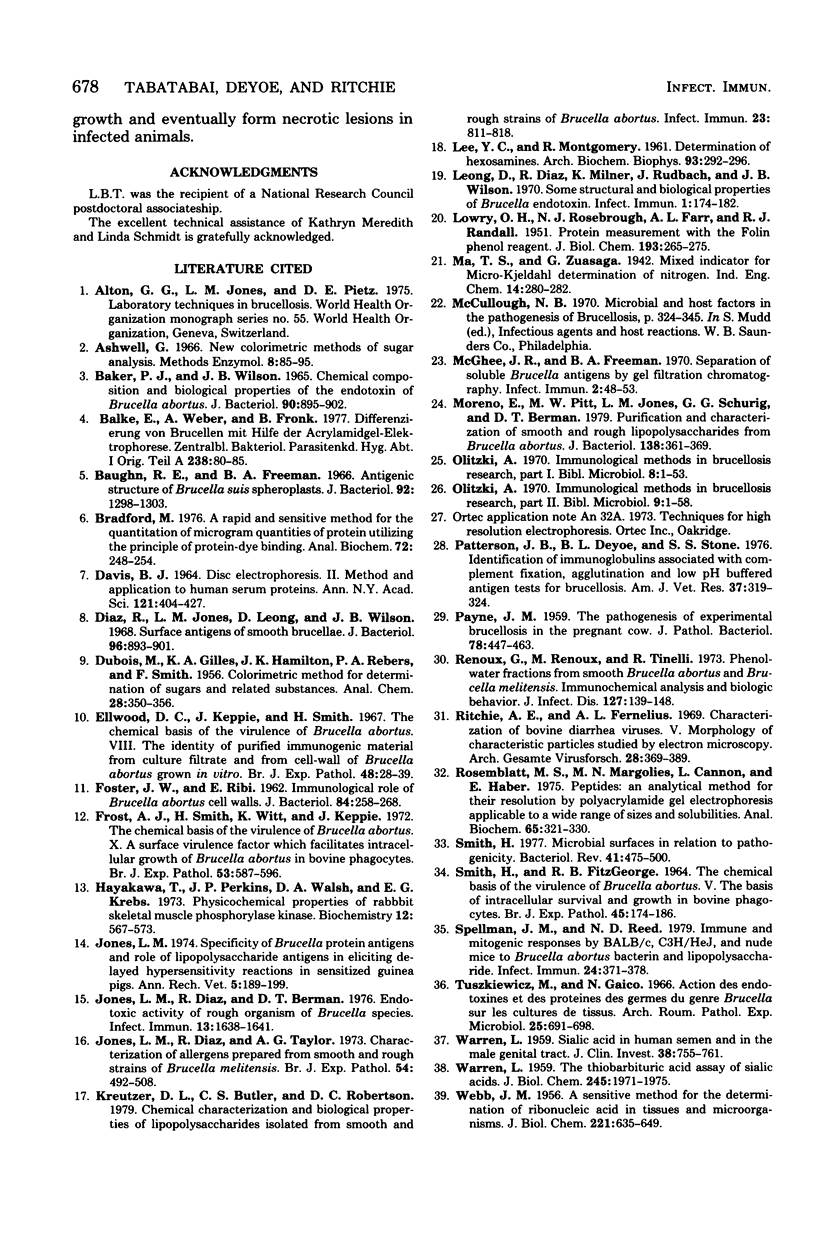
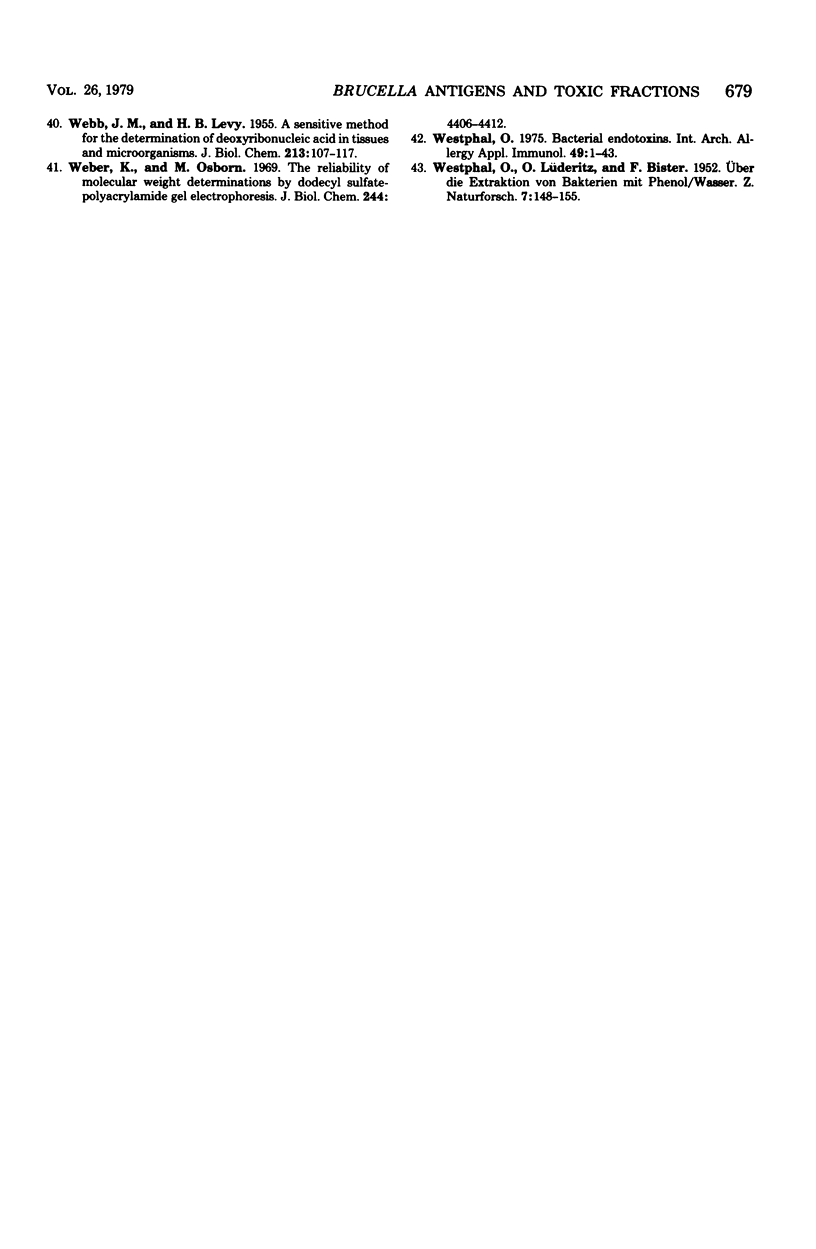
Images in this article
Selected References
These references are in PubMed. This may not be the complete list of references from this article.
- Baker P. J., Wilson J. B. Chemical composition and biological properties of the endotoxin of Brucella abortus. J Bacteriol. 1965 Oct;90(4):895–902. doi: 10.1128/jb.90.4.895-902.1965. [DOI] [PMC free article] [PubMed] [Google Scholar]
- Balke E., Weber A., Fronk B. Differenzierung von Brucellen mit Hilfe der Acrylamidgel-Elektrophorese. Zentralbl Bakteriol Orig A. 1977 May;238(1):80–85. [PubMed] [Google Scholar]
- Baughn R. E., Freeman B. A. Antigenic structure of Brucella suis spheroplasts. J Bacteriol. 1966 Nov;92(5):1298–1303. doi: 10.1128/jb.92.5.1298-1303.1966. [DOI] [PMC free article] [PubMed] [Google Scholar]
- Bradford M. M. A rapid and sensitive method for the quantitation of microgram quantities of protein utilizing the principle of protein-dye binding. Anal Biochem. 1976 May 7;72:248–254. doi: 10.1016/0003-2697(76)90527-3. [DOI] [PubMed] [Google Scholar]
- DAVIS B. J. DISC ELECTROPHORESIS. II. METHOD AND APPLICATION TO HUMAN SERUM PROTEINS. Ann N Y Acad Sci. 1964 Dec 28;121:404–427. doi: 10.1111/j.1749-6632.1964.tb14213.x. [DOI] [PubMed] [Google Scholar]
- Diaz R., Jones L. M., Leong D., Wilson J. B. Surface antigens of smooth brucellae. J Bacteriol. 1968 Oct;96(4):893–901. doi: 10.1128/jb.96.4.893-901.1968. [DOI] [PMC free article] [PubMed] [Google Scholar]
- Ellwood D. C., Keppie J., Smith H. The chemical basis of the virulence of Brucella abortus. 8. The identity of purified immunogenic material from culture filtrate and from the cell-wall of Brucella abortus grown in vitro. Br J Exp Pathol. 1967 Feb;48(1):28–39. [PMC free article] [PubMed] [Google Scholar]
- FOSTER J. W., RIBI E. Immunological role of Brucella abortus cell walls. J Bacteriol. 1962 Aug;84:258–268. doi: 10.1128/jb.84.2.258-268.1962. [DOI] [PMC free article] [PubMed] [Google Scholar]
- Frost A. J., Smith H., Witt K., Keppie J. The chemical basis of the virulence of Brucella abortus. X. A surface virulence factor which facilitates intracellular growth of Brucella abortus in bovine phagocytes. Br J Exp Pathol. 1972 Dec;53(6):587–596. [PMC free article] [PubMed] [Google Scholar]
- Hayakawa T., Perkins J. P., Walsh D. A., Krebs E. G. Physiochemical properties of rabbit skeletal muscle phosphorylase kinase. Biochemistry. 1973 Feb;12(4):567–573. doi: 10.1021/bi00728a001. [DOI] [PubMed] [Google Scholar]
- Jones L. M., Diaz R., Berman D. T. Endotoxic activity of rough organisms of Brucella species. Infect Immun. 1976 Jun;13(6):1638–1641. doi: 10.1128/iai.13.6.1638-1641.1976. [DOI] [PMC free article] [PubMed] [Google Scholar]
- Jones L. M., Diaz R., Taylor A. G. Characterization of allergens prepared from smooth and rough strains of Brucella melitensis. Br J Exp Pathol. 1973 Oct;54(5):492–508. [PMC free article] [PubMed] [Google Scholar]
- Kreutzer D. L., Buller C. S., Robertson D. C. Chemical characterization and biological properties of lipopolysaccharides isolated from smooth and rough strains of Brucella abortus. Infect Immun. 1979 Mar;23(3):811–818. doi: 10.1128/iai.23.3.811-818.1979. [DOI] [PMC free article] [PubMed] [Google Scholar]
- LEE Y. C., MONTGOMERY R. Determination of hexosamines. Arch Biochem Biophys. 1961 May;93:292–296. doi: 10.1016/0003-9861(61)90265-x. [DOI] [PubMed] [Google Scholar]
- LOWRY O. H., ROSEBROUGH N. J., FARR A. L., RANDALL R. J. Protein measurement with the Folin phenol reagent. J Biol Chem. 1951 Nov;193(1):265–275. [PubMed] [Google Scholar]
- Leong D., Diaz R., Milner K., Rudbach J., Wilson J. B. Some structural and biological properties of Brucella endotoxin. Infect Immun. 1970 Feb;1(2):174–182. doi: 10.1128/iai.1.2.174-182.1970. [DOI] [PMC free article] [PubMed] [Google Scholar]
- McGhee J. R., Freeman B. A. Separation of soluble Brucella antigens by gel-filtration chromatography. Infect Immun. 1970 Jul;2(1):48–53. doi: 10.1128/iai.2.1.48-53.1970. [DOI] [PMC free article] [PubMed] [Google Scholar]
- Moreno E., Pitt M. W., Jones L. M., Schurig G. G., Berman D. T. Purification and characterization of smooth and rough lipopolysaccharides from Brucella abortus. J Bacteriol. 1979 May;138(2):361–369. doi: 10.1128/jb.138.2.361-369.1979. [DOI] [PMC free article] [PubMed] [Google Scholar]
- Olitzki A. Immunological methods in brucellosis research. I. In vitro procedures. Bibl Microbiol. 1970;8(1):1–249. [PubMed] [Google Scholar]
- PAYNE J. M. The pathogenesis of experimental brucellosis in the pregnant cow. J Pathol Bacteriol. 1959 Oct;78:447–463. doi: 10.1002/path.1700780211. [DOI] [PubMed] [Google Scholar]
- Patterson J. M., Deyoe B. L., Stone S. S. Identification of immunoglobulins associated with complement fixation, agglutination, and low pH buffered antigen tests for brucellosis. Am J Vet Res. 1976 Mar;37(3):319–324. [PubMed] [Google Scholar]
- Renoux G., Renoux M., Tinelli R. Phenol-water fractions from smooth Brucella abortus and Brucella melitensis: immunochemical analysis and biologic behavior. J Infect Dis. 1973 Feb;127(2):139–148. doi: 10.1093/infdis/127.2.139. [DOI] [PubMed] [Google Scholar]
- Ritchie A. E., Fernelius A. L. Characterization of bovine viral diarrhea viruses. V. Morphology of characteristic particles studied by electron microscopy. Arch Gesamte Virusforsch. 1969;28(3):369–389. doi: 10.1007/BF01240951. [DOI] [PubMed] [Google Scholar]
- Rosemblatt M. S., Margolies M. N., Cannon L. E., Haber E. Peptides: an analytical method for their resolution by polyacrylamide gel electrophoresis applicable to a wide range of sizes and solubilities. Anal Biochem. 1975 May 12;65(1-2):321–330. doi: 10.1016/0003-2697(75)90516-3. [DOI] [PubMed] [Google Scholar]
- SMITH H., FITZGEORGE R. B. THE CHEMICAL BASIS OF THE VIRULENCE OF BRUCELLA ABORTUS. V. THE BASIS OF INTRACELLULAR SURVIVAL AND GROWTH IN BOVINE PHAGOCYTES. Br J Exp Pathol. 1964 Apr;45:174–186. [PMC free article] [PubMed] [Google Scholar]
- Smith H. Microbial surfaces in relation to pathogenicity. Bacteriol Rev. 1977 Jun;41(2):475–500. doi: 10.1128/br.41.2.475-500.1977. [DOI] [PMC free article] [PubMed] [Google Scholar]
- Spellman J. M., Reed N. D. Immune and mitogenic responses by BALB/c, C3H/HeJ, and nude mice to Brucella abortus bacterin and lipopolysaccharide. Infect Immun. 1979 May;24(2):371–378. doi: 10.1128/iai.24.2.371-378.1979. [DOI] [PMC free article] [PubMed] [Google Scholar]
- Tuszkiewicz M., Gaico N. Action des endotoxines et des protéines des germes du genre Brucella sur les cultures de tissus. Arch Roum Pathol Exp Microbiol. 1966 Sep;25(3):691–698. [PubMed] [Google Scholar]
- WARREN L. Sialic acid in human semen and in the male genital tract. J Clin Invest. 1959 May;38(5):755–761. doi: 10.1172/JCI103856. [DOI] [PMC free article] [PubMed] [Google Scholar]
- WARREN L. The thiobarbituric acid assay of sialic acids. J Biol Chem. 1959 Aug;234(8):1971–1975. [PubMed] [Google Scholar]
- WEBB J. M. A sensitive method for the determination of ribonucleic acid in tissues and microorganisms. J Biol Chem. 1956 Aug;221(2):635–649. [PubMed] [Google Scholar]
- WEBB J. M., LEVY H. B. A sensitive method for the determination of deoxyribonucleic acid in tissues and microorganisms. J Biol Chem. 1955 Mar;213(1):107–117. [PubMed] [Google Scholar]
- Weber K., Osborn M. The reliability of molecular weight determinations by dodecyl sulfate-polyacrylamide gel electrophoresis. J Biol Chem. 1969 Aug 25;244(16):4406–4412. [PubMed] [Google Scholar]
- Westphal O. Bacterial endotoxins. The second Carl Prausnitz Memorial Lecture. Int Arch Allergy Appl Immunol. 1975;49(1-2):1–43. [PubMed] [Google Scholar]



